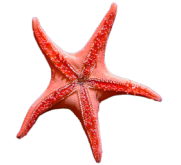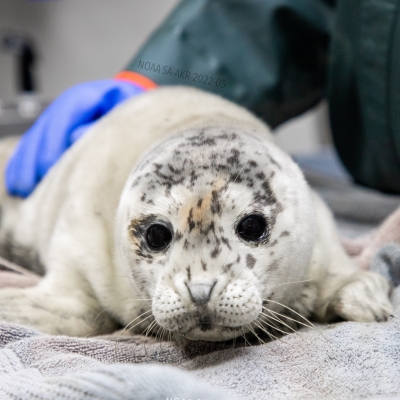First Patients of the Summer Admitted to ASLC Wildlife Response Program May 15, 2024
The Alaska SeaLife Center Wildlife Response Program has admitted two premature harbor seal pups from Kenai, Alaska. Despite incredible efforts, one pup has passed away and the other is in serious condition.
The ASLC is currently caring for a premature female harbor seal pup admitted on May 9, 2024, found abandoned and malnourished in Kenai, Alaska. The pup is still covered in its white lanugo coat, indicating a premature birth.
This is the Alaska SeaLife Center Wildlife Response Program’s second premature harbor seal patient admitted this season, as another premature pup was admitted on April 24, 2024, from Nikiski, Alaska. Despite the ASLC team’s incredible effort, the first premature harbor seal patient became critical and passed away within 48 hours of being admitted. A necropsy revealed that the pup was likely born weeks prematurely and his organs weren’t developed enough to allow him to thrive.
The current patient, admitted on May 9, 2024, is in serious condition. Community members working at a fish processing facility in Kenai called the ASLC 24-hour Wildlife Response Hotline to report that a small white-furred pup had been on their property for several hours without seeing an adult nearby.
Community members who first spotted her in Kenai, Alaska reported a malnourished and abandoned harbor seal pup to the ASLC 24-hour Wildlife Response Hotline. NOAA officers responded and confirmed that there was no mother in sight. They knew that the pup was prematurely born, as indicated by her white lanugo coat, and that she likely wouldn’t survive without immediate intervention. After receiving approval from NOAA, the pup was transported to the Alaska SeaLife Center for treatment by the officers.
The main concerns found by the veterinary team upon her initial admit exam were malnourishment, low body temperature, and abnormal bloodwork results indicating this seal was premature. The team is currently providing initial stabilizing treatments and examining the patient further to understand the severity of the animal’s condition. Premature harbor seal pups have only about a 50% chance of survival when admitted to a wildlife response program, and the team is doing everything possible to give her a fighting chance.
Harbor seal pups typically shed their white lanugo coat in utero before being born, so any time a pup of this species is seen with a white coat, it indicates that it was born prematurely. However, this isn’t true for all species of seals in Alaska. Ice seal pups, like spotted and ringed seals, are born with white lanugo coats and do not shed them for four to six weeks after birth. Location helps experts know which species of seal pup they are looking at in Alaska. Typically, the ice seal species normally born with a white lanugo coat are found in the northern half of Alaska’s coastline. Harbor seals are typically found along the southern half of Alaska’s coastline.
The ASLC will share updates on this delicate patient’s progress on their Facebook and Instagram pages.
Call first! Before approaching an injured or stranded marine animal in Alaska, call the 24-hour Stranded Marine Animal Hotline at 1-888-774-SEAL(7325).
The Alaska SeaLife Center’s Wildlife Response Program can only provide care for stranded and injured marine animals with help from corporate sponsors and individual donors. If you are interested in contributing to the care of these patients, visit the ASLC’s website: www.alaskasealife.
The Center acknowledges the ongoing generous support of the Wildlife Response Program from supporters like ConocoPhillips Alaska, Marathon Petroleum Corporation, PetZoo, Partners 4 Wildlife, Matson, GCI, and a number of individual donors, funds, and foundations such as Stanley J Williams Fund.



